Overview
In Australia, business loans follow a structured process that begins with:
- Assessing financial needs
- Preparing essential documentation
- Understanding the various types of loans available, including both secured and unsecured options
Successful loan applications hinge on meticulous preparation and a thorough understanding of market dynamics. This knowledge empowers entrepreneurs to align their financing strategies with specific business goals. Are you ready to navigate this landscape effectively? By equipping yourself with the right insights, you can enhance your chances of securing the funding you need to thrive.
Introduction
In the dynamic landscape of Australian business financing, grasping the intricacies of business loans is essential for entrepreneurs eager to fuel their growth and operational success. With a diverse array of options available—from secured loans requiring collateral to flexible lines of credit—navigating this financial terrain may seem daunting, yet it can be immensely rewarding. As the demand for business loans continues to surge, propelled by a robust economy and evolving market conditions, the ability to make informed decisions becomes paramount.
This article explores the various types of business loans, outlines the critical steps for successful applications, and highlights common pitfalls to avoid, equipping business owners with the knowledge necessary to secure the funding they need to thrive.
Understanding Business Loans: An Overview
Business financing serves as essential financial instruments that empower businesses to secure the capital needed for operations, expansion, or effective cash flow management. In Australia, these financial products are categorized into secured and unsecured options, each with distinct terms and conditions. Secured financing necessitates collateral, which can mitigate risk for lenders, while unsecured financing offers flexibility without the need for assets to back the agreement.
As of 2025, the landscape of financial agreements in Australia is characterized by significant activity, with new commitments ranging from $5.39 billion to $22.22 billion, reflecting a robust demand for funding solutions. In the December quarter of 2024 alone, there were 46,166 internal refinanced owner-occupier commitments, alongside 61,749 external commitments and 18,274 investor commitments, indicating a dynamic market.
For entrepreneurs, grasping the essential aspects of financial assistance is vital. These financial products typically provide varying repayment terms, interest rates, and eligibility criteria, which can significantly affect an enterprise's financial health. The capability to navigate these options efficiently can result in successful funding applications, allowing enterprises to obtain the resources they require.
Finance Story specializes in creating polished and highly individualized cases to present to banks, ensuring that clients meet the increasingly heightened expectations around securing funds for their developments.
Current patterns in the financing sector emphasize the significance of remaining knowledgeable. For instance, the category 'Other' in personal fixed-term credits experienced a notable 3.9% increase from the September to the December quarter of 2024, with a year-on-year surge of 25.9%. This trend highlights the evolving nature of financing options available to enterprises.
Moreover, a case study on data quality concerns in reporting reveals that revisions made between March 2022 and December 2023 have slightly increased the levels of certain credit series. This highlights the significance of precise reporting in comprehending the financial landscape and its effects on borrowers.
Expert opinions also emphasize the necessity for entrepreneurs to educate themselves about the intricacies of loans. As Shaun McGowan, founder of Money.com.au, observes, "The aim is to assist individuals and enterprises in reducing expenses linked to financial products through education and advanced technology." This emphasizes the critical role that knowledge plays in navigating the complexities of financing.
In summary, a thorough comprehension of how business loans work in Australia is essential for entrepreneurs aiming to make informed funding choices. By becoming acquainted with the different kinds of financing available, the current market dynamics, and the significance of precise data reporting, owners can position themselves to obtain the most fitting funding options for their specific requirements. Working with Finance Story, you will have access to a full suite of lenders, ensuring that your financing solutions are tailored to your specific circumstances.
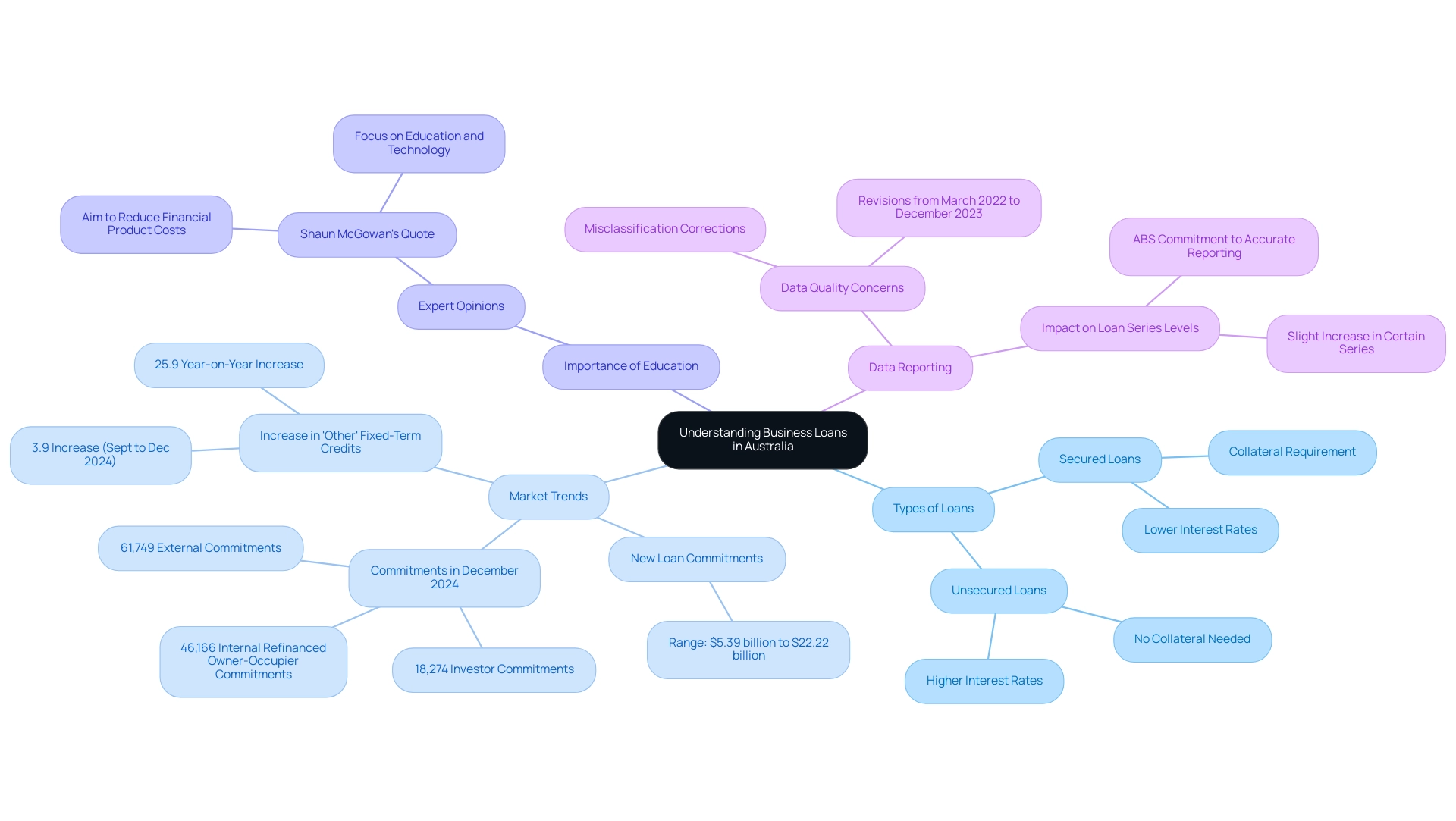
Types of Business Loans Available in Australia
In Australia, enterprises can gain a comprehensive understanding of how business loans work to access a diverse range of financing options tailored to their specific financial needs. Grasping the mechanics of business loans is crucial for aligning financing strategies with organizational goals. The primary categories of financing options available include:
-
Term Financing: These conventional funds come with a fixed repayment plan and are typically utilized for significant investments, such as purchasing property or enhancing operations. They offer stability through predictable payments, making them a favored choice among established companies.
-
Lines of Credit: This flexible financing option enables businesses to withdraw funds as necessary, up to a set limit. It is particularly beneficial for managing cash flow fluctuations, allowing companies to address unexpected expenses or seize immediate opportunities without the need for a full financing application each time.
-
Equipment Financing: Specifically designed for acquiring equipment, this funding type uses the equipment itself as collateral. This means that businesses can secure essential tools or machinery without straining their cash flow, as the financing is backed by the asset being financed.
-
Invoice Financing: This short-term funding leverages outstanding invoices, providing immediate cash flow to businesses awaiting payments from clients. It empowers companies to maintain operations and invest in growth while waiting for receivables to be settled.
-
Merchant Cash Advances: This option delivers a lump sum payment in exchange for a percentage of future credit card sales. It is particularly advantageous for businesses with high volumes of credit card transactions, offering swift access to capital without the lengthy approval processes typical of traditional loans.
Recent statistics reveal that corporate credit card spending soared to an unprecedented $8.64 billion in June 2024, reflecting a growing dependence on flexible financing solutions among Australian firms. Additionally, the agriculture, forestry, and fishing support services sector boasts a profit margin of 20.2%, highlighting the potential for lucrative investments through strategic financing.
By understanding how business loans operate in Australia, companies can make informed decisions that align with their financial strategies and operational requirements, ultimately enhancing their prospects for success in a competitive market. At Finance Story, we distinguish ourselves in the market through our innovative lending process, offering customized options that cater to the unique needs of enterprises. Our expertise in crafting polished and highly individualized loan proposals ensures that clients can secure the right financing for their commercial property investments, whether they are acquiring a warehouse, retail space, factory, or hospitality venture.
We also specialize in refinancing options to adapt to the evolving needs of businesses, ensuring that our clients can adjust their financing strategies as their operations expand. With access to a comprehensive suite of lenders, including high street banks and innovative private lending panels, we are well-equipped to assist clients in navigating challenging financial landscapes and achieving their goals efficiently.
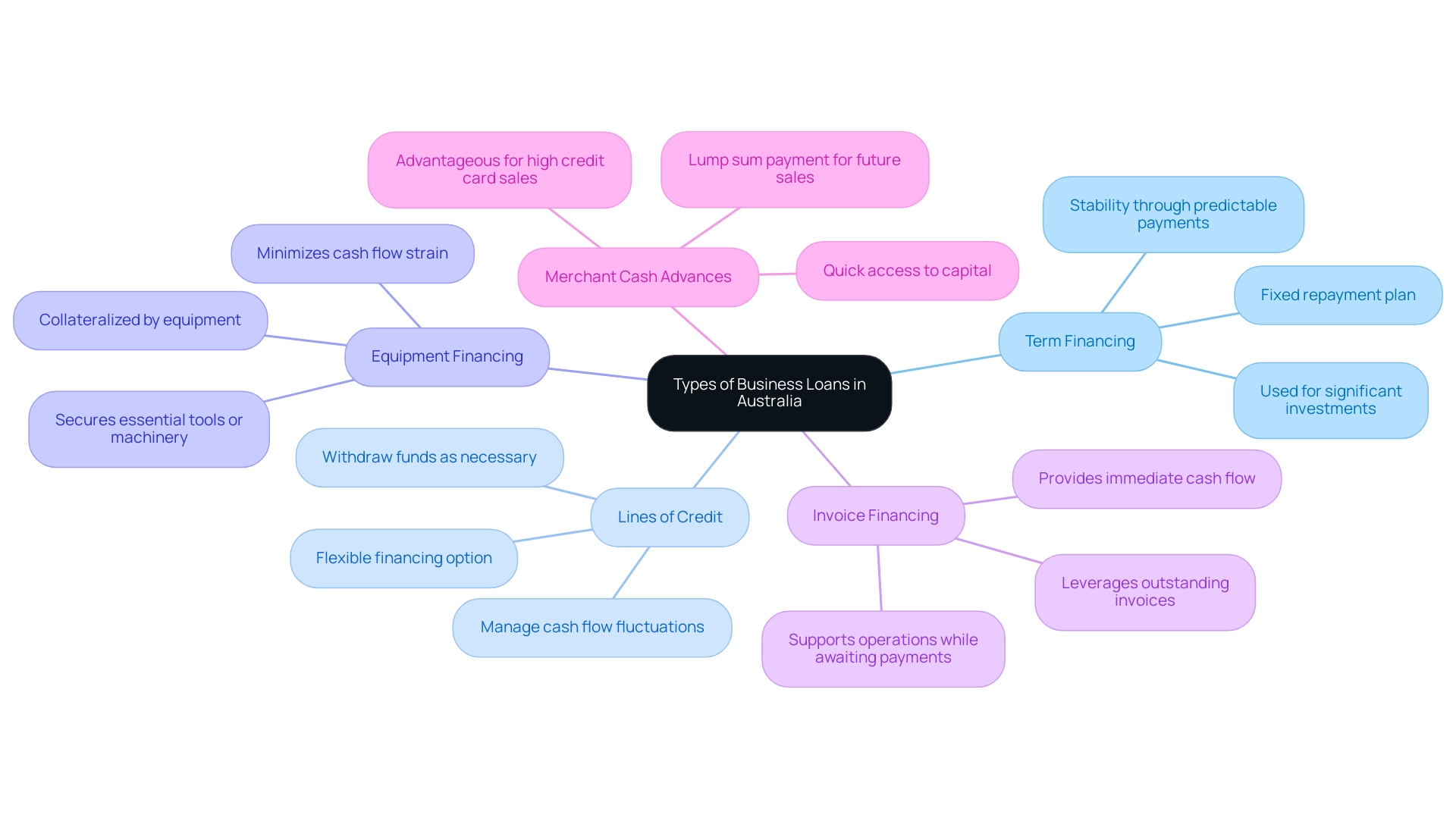
Preparing for Your Business Loan Application: Key Requirements
Before embarking on the journey to secure a loan, it is crucial to compile a comprehensive set of documents that will support your application, particularly when considering how business loans work in Australia. The following key documents are essential:
-
Enterprise Plan: This document should present a clear outline of your objectives, strategies for achieving them, and detailed economic projections. A well-structured plan not only guides your operations but also serves as a critical tool for lenders to evaluate your enterprise's viability. Lenders frequently demand a plan that contains monetary forecasts and funding needs to assess the overall economic condition of your enterprise.
-
Monetary Reports: Recent monetary statements, including profit and loss reports, balance sheets, and cash flow reports, are essential. These documents demonstrate your company's economic status and operational performance, providing creditors insight into your capacity to repay the loan.
-
Tax Returns: Submitting personal and professional tax returns for the last two years is essential to confirm your income and show economic stability. This documentation assists creditors in assessing your monetary history and dependability.
-
Identification: Personal identification documents, such as a driver's license or passport, are required to confirm your identity and ensure compliance with regulatory standards.
-
Credit History: A report detailing your credit history is essential for assessing your creditworthiness. Lenders will review this information to gauge the risk associated with lending to you. Understanding how business loans work in Australia can significantly streamline the application process and improve your chances of success.
In fact, statistics indicate that applications with complete documentation have a higher approval rate, underscoring the importance of thorough preparation. For example, Finance Story focuses on developing refined and highly customized proposals to present to financiers, improving your likelihood of obtaining personalized funding options. By utilizing a diverse portfolio of private financiers and mainstream financial institutions, Finance Story guarantees that clients receive personalized service that meets their unique circumstances, whether you are acquiring a warehouse, retail premise, factory, or hospitality venture.
Furthermore, if you seek to refinance your commercial financing, Finance Story can help address the changing requirements of your enterprise. This adaptability in the lending process is crucial, especially in a competitive market where the annual rise of the Australian Consumer Price Index (CPI) is currently at 4.1 percent, impacting the overall lending landscape. The ability to present a comprehensive application not only meets lender requirements but also positions your venture favorably in securing the necessary financing by understanding how business loans work in Australia.

Step-by-Step Process to Apply for a Business Loan
To understand how business loans work in Australia, applying for business financing involves a systematic approach to secure the necessary funding for your business growth. Here’s a comprehensive step-by-step guide:
- Assess Your Needs: Begin by evaluating your financial requirements. Determine the exact amount of funding you need and specify its intended use—whether for expansion, equipment purchase, or operational costs. Understanding your needs will help you articulate your request clearly.
- Research Financial Institutions: Explore various providers and their financing products. With an average loan size for owner-occupier dwellings in the Australian Capital Territory at approximately $377,000, it's crucial to compare interest rates, terms, and conditions to find the best fit for your needs. Utilize resources that provide insights into financing options and customer reviews. As Philana Kwan, Marketing Coordinator at Driva, states, "Our extensive network of over 30 financiers empowers you to make informed comparisons, helping you discover the solution that aligns perfectly with your requirements."
- Prepare Your Application: Gather all necessary documentation, including financial statements, business plans, and tax returns. A well-prepared application can significantly enhance your chances of approval. Ensure that your application form is completed accurately and includes all required attachments. The case study titled "Steps to Secure a Small Business Loan Successfully" emphasizes the importance of thorough preparation and documentation in this step.
- Submit Your Application: Once your application is ready, send it to your selected financial institution. Double-check that all information is accurate and complete to avoid delays in processing.
- Follow Up: After submission, proactively follow up with the lender to inquire about the status of your application. This demonstrates your commitment and can help expedite the review process.
- Review Financing Offers: If your application is approved, take the time to carefully examine the terms and conditions. Consider factors such as repayment schedules, interest rates, and any fees related to the borrowing. This step is essential to guarantee that the funding aligns with your company's financial strategy.
By adhering to these steps, you can simplify the application procedure and enhance your likelihood of securing the required financing for your enterprise. Furthermore, collaborating with Finance Story can offer you customized financing proposals and access to a complete range of lenders, including high street banks and innovative private lending panels, ensuring that you discover the right funding solution for your commercial property investments—whether it be a warehouse, retail premise, factory, or hospitality venture. To further enhance your strategy, consider scheduling a free personalized consultation with Shane Duffy, Head of Funding Solutions at Finance Story, to discuss your specific needs and goals.
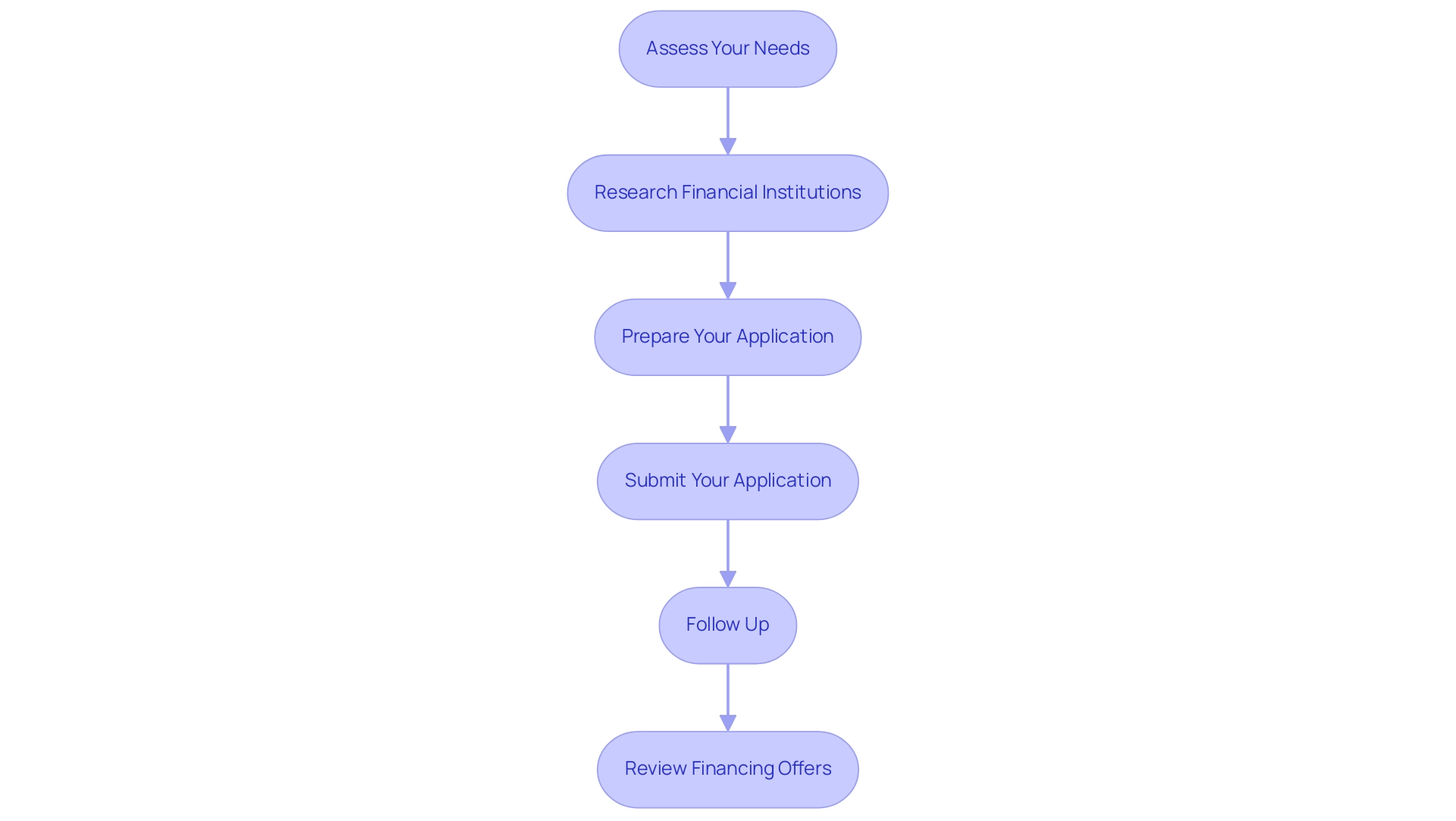
How Lenders Evaluate Business Loan Applications
Lenders evaluate business loan applications based on several critical factors that significantly influence the approval process:
- Credit Score: A robust credit score serves as a key indicator of an applicant's reliability. In Australia, understanding how business loans work can greatly benefit successful financing applicants. Those with average credit scores exceeding 700 typically enhance their chances of obtaining favorable terms.
- Financials: Lenders meticulously review financial statements, including profit and loss statements and cash flow projections, to assess the organization's profitability and financial health. This analysis aids lenders in evaluating the applicant's capability to repay the amount.
- Plan: A well-structured plan is essential. It should clearly define the purpose of the funding, the intended use of resources, and how the financing will contribute to the growth and sustainability of the enterprise. A compelling business plan can significantly strengthen an application.
- Collateral: For secured credit, the value and type of collateral offered can greatly influence the amount and terms. Lenders often prefer tangible assets that can be easily liquidated in case of default.
- Industry Experience: Lenders may assess the applicant's experience within their industry as a risk factor. A strong track record can instill confidence in lenders regarding the applicant's ability to navigate market challenges.
Understanding how business loans work in Australia is crucial for applicants aiming to tailor their submissions effectively. In 2025, the total value of new loan commitments for personal fixed-term loans reached $8.43 billion, reflecting a competitive lending environment that also affects commercial loans. By aligning their applications with these key factors, business owners can enhance their chances of approval and learn how business loans work in Australia to secure the financing necessary for growth.
Furthermore, innovative lending solutions, such as those offered by Finance Story, provide access to a diverse portfolio of private lenders and mainstream financial institutions. This adaptability allows clients to explore tailored options that meet their unique circumstances, further improving their prospects in the lending process. As Philana Kwan, Marketing Coordinator at Driva, states, "Our extensive network of over 30 financiers empowers you to make informed comparisons, helping you discover the solution that aligns perfectly with your requirements."
This highlights the importance of having a broad range of options when seeking financing.
In addition, Finance Story's commitment to innovation and adaptability reinforces its reputation for professionalism in the finance sector. By effectively addressing the factors influencing credit approval, Finance Story ensures that its clients receive the most suitable funding options tailored to their specific situations.
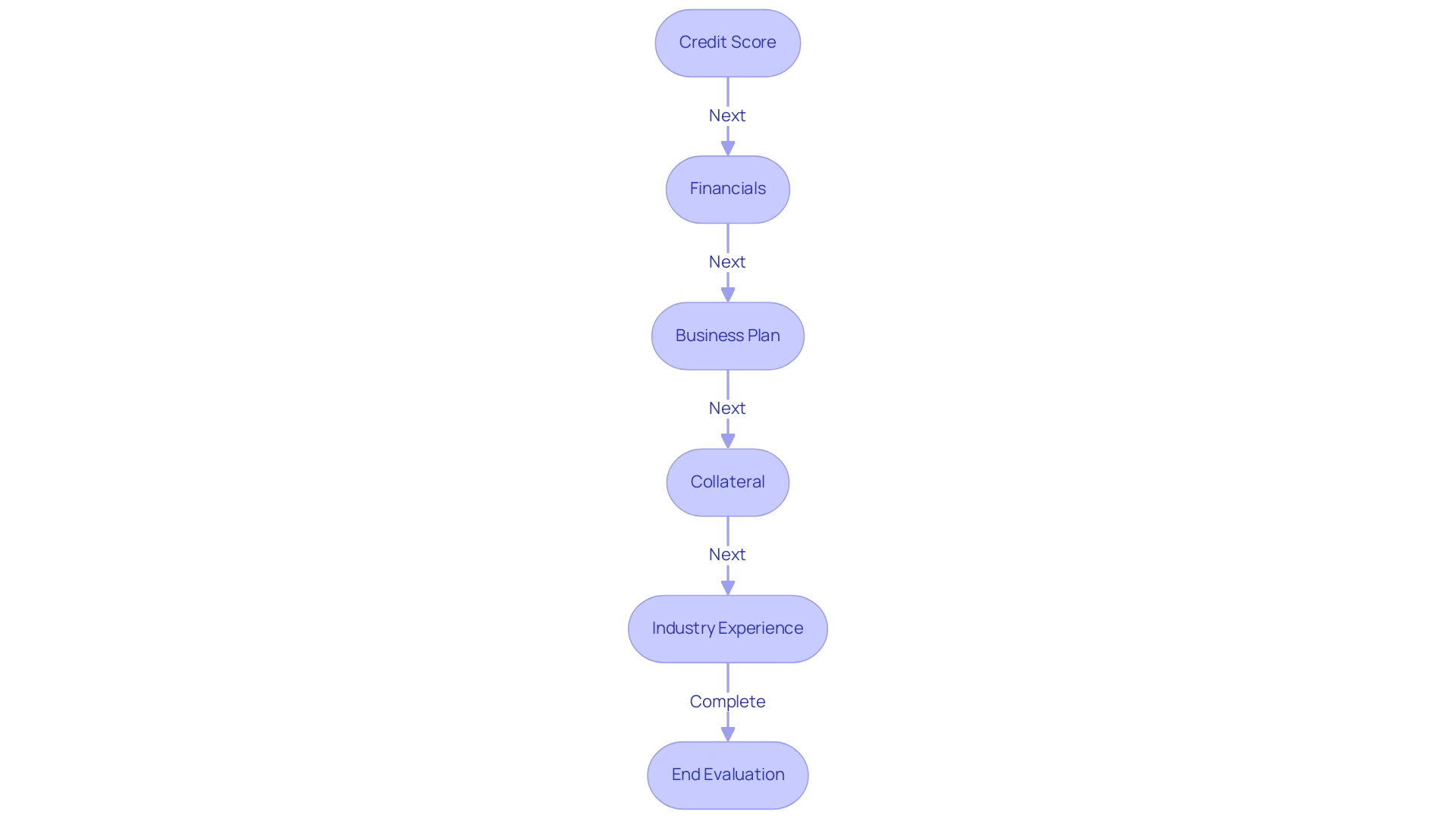
Understanding Interest Rates and Repayment Terms
To understand how business loans work in Australia, it is essential to recognize that interest rates are influenced by a variety of factors, leading to significant variability across different lending options. Key determinants include:
- Credit Type: Secured credits generally offer lower interest rates compared to unsecured credits. This is primarily due to the reduced risk for financial institutions, as secured loans are backed by collateral, providing a safety net in case of default.
- Creditworthiness: The borrower's credit score plays a crucial role in determining interest rates. A higher credit score typically results in more favorable rates, reflecting the financial institution's confidence in the borrower's ability to repay the loan.
- Market Conditions: Broader economic factors, including inflation rates and central bank policies, can significantly impact overall lending rates. For instance, as of 2025, current trends indicate a gradual increase in interest rates, influenced by the Reserve Bank of Australia's monetary policy adjustments aimed at controlling inflation.
Finance Story's professionalism and deep understanding of the finance sector enhance its ability to assist clients in navigating these complexities. The brokerage specializes in creating polished and highly individualized cases to present to banks, ensuring clients secure the most suitable financing options for their needs. With access to a diverse portfolio of private lenders, including innovative and entrepreneurial private lending panels, and mainstream institutions, Finance Story is committed to innovation and adaptability, providing tailored solutions that meet the evolving requirements of small enterprises.
In Australia, understanding how business loans work is crucial, as repayment terms for funds exhibit considerable variation, with options ranging from short-term advances of 1 to 3 years to long-term arrangements that can extend up to 30 years. The typical repayment duration frequently corresponds with the credit type and intention, enabling borrowers to choose terms that best suit their economic capabilities and enterprise strategies.
For instance, small enterprises seeking quick capital may opt for short-term credits with higher interest rates, while established firms looking for substantial funding might select longer repayment periods to manage cash flow more effectively. Grasping how business loans work in Australia is vital for borrowers to make informed choices that align with their financial strategies.
In 2025, the average amount borrowed for owner-occupier dwellings in the Australian Capital Territory stands at approximately $377,000. This figure reflects broader market dynamics and lending practices, and it is important for small enterprise owners to consider how typical financing amounts compare. Case studies show that companies utilizing customized financing options from brokers such as Finance Story have effectively managed the challenges of obtaining funding, gaining from innovative solutions and a varied collection of lenders.
This adaptability not only enhances service offerings but also solidifies Finance Story's position as a leader in the finance sector.
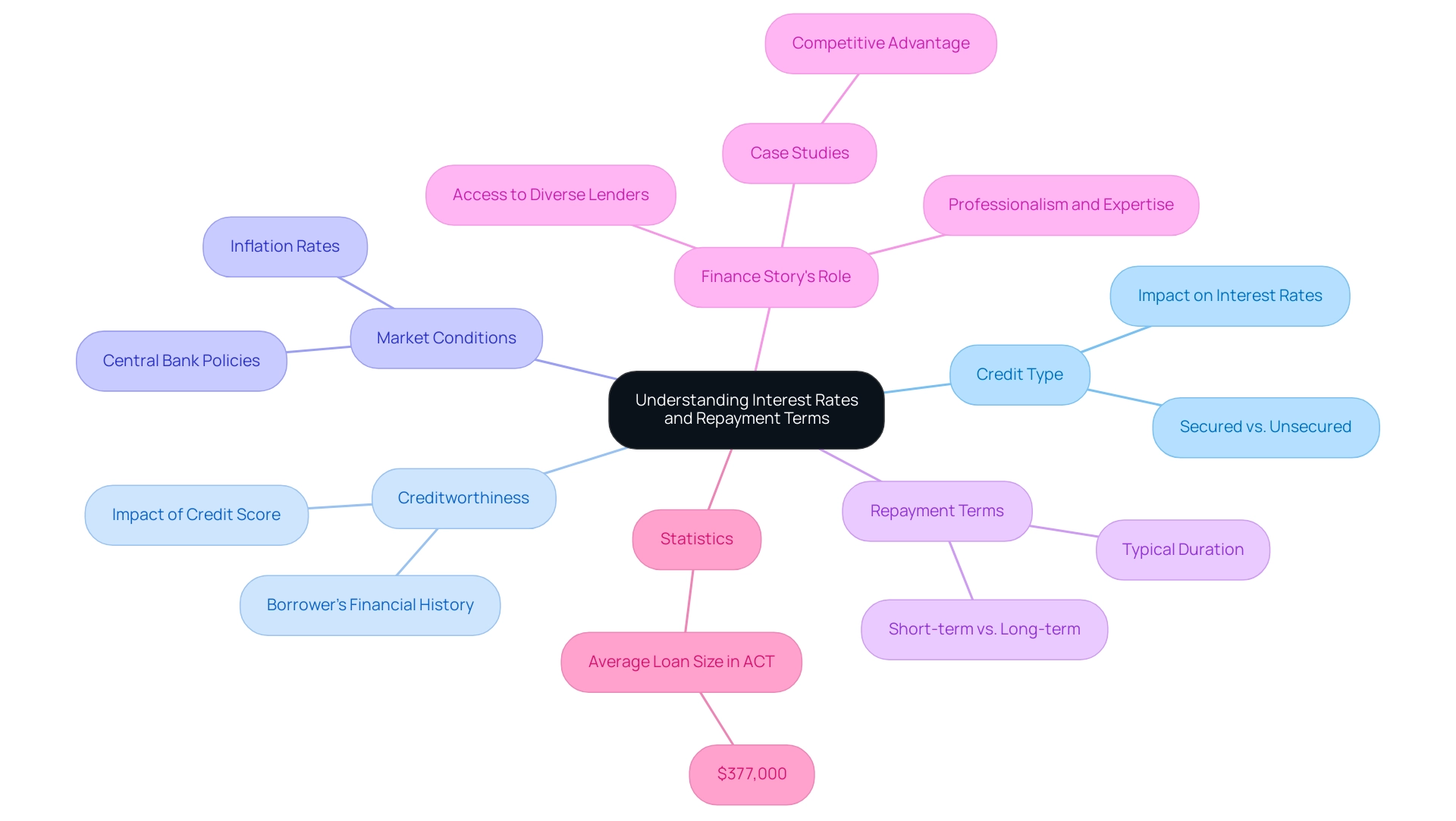
Common Mistakes to Avoid When Applying for a Business Loan
When seeking funding for a venture, it is crucial to avoid common pitfalls that can jeopardize your chances of approval:
-
Incomplete Documentation: Submitting all required documents is essential. In Australia, research indicates that a significant percentage of loan application rejections stem from incomplete documentation. Many applicants face rejection due to missing paperwork. Ensuring that every necessary document is included can prevent unnecessary delays and enhance your application's credibility.
-
Ignoring Credit Scores: Before submitting your application, check your credit score. Many applicants overlook this step, leading to surprises during the approval process. Addressing any discrepancies or issues in advance can significantly improve your chances of securing a loan.
-
Lack of a Solid Plan: A well-structured plan is vital. A weak or vague plan can undermine your application, as lenders want to see a clear vision and strategy for your business. Emphasizing your objectives, market analysis, and economic projections can bolster your case.
-
Overborrowing: It’s tempting to request more than you need, but this can lead to unnecessary debt. Lenders prefer applicants who demonstrate a clear understanding of their financial needs. Only request the amount necessary to achieve your business objectives, which shows fiscal responsibility.
-
Rushing the Application: Take your time to ensure accuracy and completeness. Hurrying through the application can result in errors that may cost you the funding. A meticulous approach not only reflects professionalism but also increases your chances of approval.
By being mindful of these common mistakes, applicants can significantly enhance their likelihood of securing the financing they need. Additionally, seeking guidance from experienced mortgage brokers like Finance Story can provide valuable insights and help navigate the complexities of the loan application process, ultimately saving time and avoiding costly errors. With a specialization in creating polished and personalized cases for banks, Finance Story is well-equipped to assist clients in achieving their financial goals efficiently and effectively. Furthermore, Finance Story provides access to a complete variety of lenders, including high street banks and innovative private lending panels, and can assist with refinancing options to meet the changing demands of your enterprise. Whether you are aiming to acquire a warehouse, retail space, factory, or hospitality project, Finance Story is here to assist you in obtaining the right funding.

Exploring Alternative Financing Options for Businesses
In addition to traditional loans, enterprises in Australia can explore a variety of alternative financing options that cater to their unique needs in 2025:
-
Grants: Both government and private grants provide funding opportunities that do not require repayment, making them an attractive option for startups and established enterprises alike. These grants support various initiatives, from research and development to community projects, offering a financial boost without the burden of debt.
-
Crowdfunding: Platforms such as Kickstarter and Indiegogo enable enterprises to raise capital directly from the public. This method not only secures funding but also validates ideas through community support. Statistics indicate that crowdfunding success rates for Australian enterprises have been on the rise, with many campaigns exceeding their funding goals, showcasing the potential of this approach. As Alan Shields observes, social media is transforming product decisions, with 76% of consumers seeking guidance from platforms like TikTok and Instagram, emphasizing the significance of utilizing these platforms for funding insights.
-
Peer-to-Peer Lending: This innovative funding method allows enterprises to borrow from individual investors through online platforms. Peer-to-peer lending often illustrates how business loans work in Australia, providing more flexible terms compared to traditional banks, making it a viable option for enterprises that may struggle to secure conventional loans.
-
Angel Investors: Wealthy individuals, known as angel investors, provide capital in exchange for equity or convertible debt. This funding can be vital for startups aiming to grow rapidly, as angel investors frequently offer not only monetary support but also valuable industry knowledge and connections.
Shane, as the Founder and Funding Specialist Director at Finance Story, utilizes his extensive experience in organizational enhancement and funding solutions to assist small enterprise owners through these alternative financing pathways. With a BEng Hons in Manufacturing Engineering and a Diploma in Finance & Mortgage Broking, Shane's qualifications enhance his credibility in the field. His insights into utilizing property equity and cash savings for acquisitions, along with understanding how business loans work in Australia and loan repayment criteria, empower organizations to find the most suitable funding solutions tailored to their specific circumstances.
Finance Story specifically assists clients by providing tailored advice and support in navigating these financing options, ensuring they make informed decisions. As the economic landscape changes, staying updated about these choices is crucial for navigating the intricacies of obtaining funding in Australia. Notably, with home values in Sydney and Melbourne declining for the first time in nearly two years, businesses must consider how current market conditions may influence their financing decisions.
The case study of Finance Story illustrates how a boutique mortgage brokerage successfully navigates these complexities, providing tailored financial solutions that meet the diverse needs of clients.
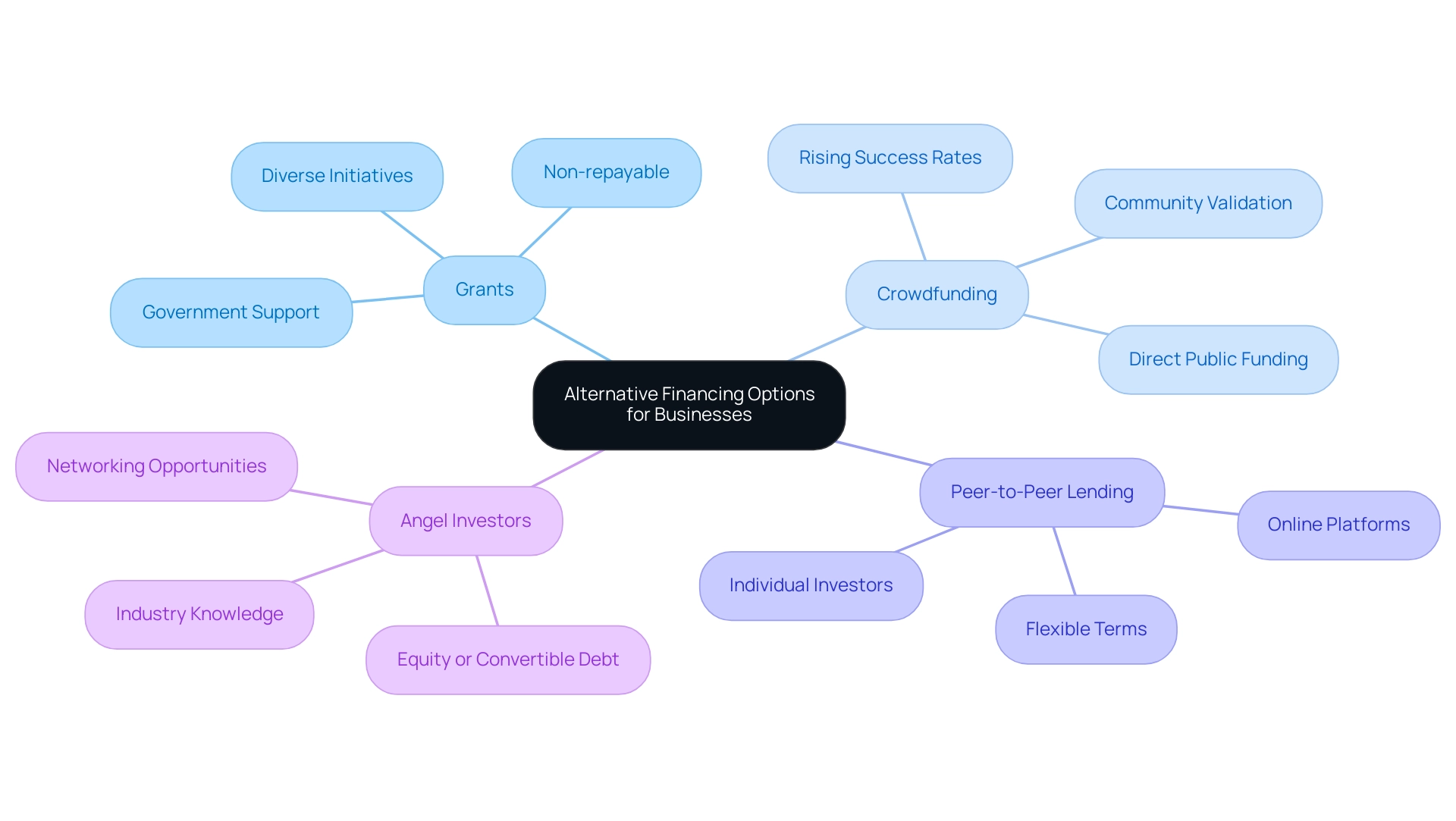
Conclusion
Understanding the nuances of business loans is essential for entrepreneurs in Australia aiming to secure the necessary funding for growth and operational success. This article outlines the various types of loans available, including:
- Secured options
- Unsecured options
- Term loans
- Lines of credit
- Specialized financing such as equipment and invoice financing
Each type serves different financial needs, emphasizing the importance of aligning loan choices with specific business goals.
Preparation for a successful loan application involves assembling critical documents such as:
- A comprehensive business plan
- Financial statements
- Tax returns
By meticulously adhering to the application process and avoiding common pitfalls like incomplete documentation and lack of a solid business plan, entrepreneurs can significantly enhance their chances of approval. It is crucial to understand how lenders evaluate applications, focusing on factors such as credit scores, business financials, and collateral.
Furthermore, alternative financing options like:
- Grants
- Crowdfunding
- Peer-to-peer lending
- Angel investors
offer additional avenues for businesses seeking financial support. These options can provide necessary capital without the burdens of traditional loans, especially in a competitive market where adaptability is key.
Ultimately, the ability to navigate the complex landscape of business financing in Australia requires informed decision-making and thorough preparation. By leveraging expert resources and understanding the various financing options available, entrepreneurs can position themselves to secure the funding needed to thrive in an ever-evolving business environment.

